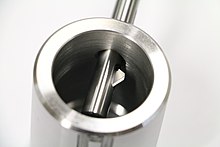Resources
Deburring
There are many deburring processes, but the most common are mass-finishing, spindle finishing, media blasting, sanding, grinding, wire brushing, abrasive flow machining, electrochemical deburring, electropolishing, thermal energy method, machining, and manual deburring.[5]
Manual deburring[edit]
Manual deburring is the most common deburring process because it is the most flexible process. It also only requires low cost tools and allows for instant inspection.[6] Manual deburring is either done with tools like scrapers, files, sandpaper, stones and reamers or with handheld power tools that use abrasive points, sandpaper, or cutters similar to those used to deburr during machining.
Electrochemical deburring[edit]
Electrochemical deburring is the use of electrochemical machining to deburr precision work pieces and edges that are hard-to-reach, such as intersecting holes. The process uses a salt or glycol solution and electricity to dissolve the burr. The electric current is applied with a specialized tool to reach the burr location. Burrs are removed in 5 to 10 seconds, while the rest of the work piece is unaffected.[6]
Thermal energy method[edit]
Thermal energy method (TEM), also known as thermal deburring, is a deburring process used to remove hard-to-reach burrs or burrs from multiple surfaces at the same time. The process uses an explosive gas mixture to provide thermal energy to burn off the burrs. It is the fastest burr removal process, requiring only 20 milliseconds to remove a burr.[7]
The process starts by loading the workpiece into an explosion-proof chamber, which is then sealed and clamped with approximately 220 metric tons (240 short tons). The chamber is then evacuated of air and filled with an oxygen and fuel mix; this mixture is pressurized to 0.5 to 1.9 MPa (73 to 276 psi). An electrical igniter then ignites the mixture, which burns for approximately 20 milliseconds, causing all of the sharp corners and burrs to burn away. The peak temperature reaches 3,000 °C (5,430 °F).[7]
Cryogenic deburring[edit]
Cryogenic deburring is a cryogenic process used to remove burrs and flash from plastic and die cast workpieces. The process works by tumbling and/or abrasively blasting the workpieces at cryogenic temperature levels. The low temperatures (approximately −195 °C (−319.0 °F)) are achieved using liquid nitrogen, liquid carbon dioxide, or dry ice. This low temperature brings the material below its embrittlement temperature, which causes the flash or burrs to be easily removed via tumbling or media blasting. This process has been around since the 1960s to deflash plastic and rubber.[8] Common materials that are typically cryogenically deburred with blast media include PEEK, nylon, Teflon, Delrin, polypropylene, polycarbonate, acetal, PTFE, PET, HDPE, PVC, ABS and many others.[9]
Mechanical deburring[edit]
Mechanical deburring is a deburring process that either mechanically grinds a burr off of metal or rolls the edge of dangerous slit or sheared metal burrs into itself. Rolled mechanical deburring was first developed in the 1960s by Walter W. Gauer from Gauer Metal Product, Inc.[10] as a means to speed up the process of hand deburring strips of metal that were used in bakery racks.[11]
- What affects injection mold machining accuracy and productivity?
- Shenzhen top five mold manufacturers: how plastic products are processed and produced?
- Shenzhen Ideal Vowin mold manufacturer: how to effectively improve the precision of mold processing?
- Chrome plating, a process that makes cars stylish
- Six injection molding processing technologies for home appliance plastic products
- Advantages and disadvantages of injection molding vs blow molding
- What is automotive hot stamping and molding technology?
- What is the difference between a hot runner and a cold runner in the mold?
- Automotive stamping die in large, precision and other areas of progress is obvious, the rapid development of plastic and rubber molds
- The top ten problems that are likely to occur in the mold testing process















